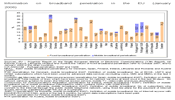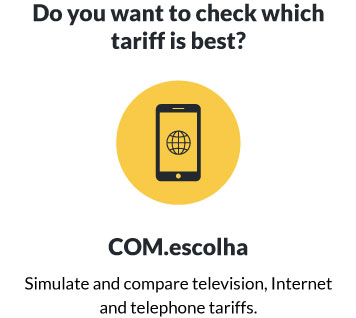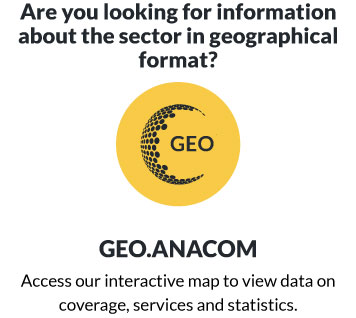As at the end of the first quarter of 2008 there were around 1,71 million users in Portugal with mobile Internet access and around 1,58 million fixed Internet accesses, of which approximately 1,52 million were broadband. For the first time the number of mobile broadband users surpassed the number of fixed broadband customers.
Mobile broadband saw the highest rate of growth during the period being reported. The number of users increased by 259 thousand over the quarter, representing a rise of almost 18% compared to the previous quarter and of 99% compared to the same quarter of 2007.
Along with the high rate of growth seen in the number of mobile broadband accesses, their use has also grown. The number of mobile broadband users who were active during the period being reported grew by around 20% over the quarter, rising to 793 thousand users, a figure that is 152% higher than the value recorded in the first quarter of 2007.
If Internet access traffic of mobile accesses is considered as an indicator of the intensity of use, growth is even higher, with the volume of traffic (in MB) in 1Q2008 up 40% over the previous quarter.
Meanwhile, the number of fixed Internet access service customers (around 1,58 million) fell by around 2.5%, compared to the previous quarter, and by 1.3% year-on-year. This is the first year-on-year decline ever recorded for the total number of fixed Internet customers.
The number of dial-up access customers continued its decline, as a result of the migration of users to broadband, with a further one-off decline recorded this quarter due to adjustments made to historical data with respect to dial-up access customers reported by certain operators. In this quarter the number of dial-up customers stood at 60 thousand, around 39 thousand less than in the previous quarter.
The majority of Internet access service customers use broadband: the customers of these services represent around 96% of all customers. The number of customers of broadband services reached 1,52 million, 2,500 thousand less than in the previous quarter. The number of fixed broadband customers fell, therefore, by 0.2% in comparison to the previous quarter but recorded an increase of 3.5% compared to the same quarter of 2007.
The decline in the number of fixed Internet access clients was caused by a fall in ADSL customers (-3%). This decrease has been seen for the second consecutive quarter, resulting in part from contractual terminations by PTC with respect, above all, to customers with pre-paid plans. Meanwhile ADSL remains the principle broadband Internet access technology, now representing 57.6% of the total. Cable modem is used by 41.2% of fixed broadband customers.
As far as market share of fixed broadband access is concerned, Grupo PT's share of customers stood at 37.3%, 2.7% down on the previous quarter.
Meanwhile the Zon/TV Cabo group held a share of 27.4% over the same period, 1.2% more than in the previous quarter.
Together, the alternative operators held a share of 35.3% during the period being reported, up 1.5 points on the previous quarter.
At the end of the first quarter, the penetration rate of broadband Internet access stood at 14.4 per 100 inhabitants for fixed access and at 16.2 per 100 inhabitants for mobile access.
In the case of fixed access, this figure is in line with the figure recorded in the previous quarter and around 0.5% higher than the figure recorded for the first quarter of 2007. It should be noted that the penetration rate for ADSL customers has been falling since the previous quarter contrary to the penetration rates recorded for cable Modem customers and customers of other types of access, which have been rising. Meanwhile the penetration rate for mobile broadband grew by 2.5% over the quarter.
According to information provided by the EU in its 13th Progress Report on the Single European Market of Electronic Communications, the penetration of the fixed Internet access service in Portugal was, in the considered period, below the average of the EU 27. In January 2008, broadband penetration in the EU27 was 20 per 100 inhabitants, while in Portugal this figure was 14.4. In the EU rankings, the position of broadband penetration in Portugal was just below that of the Czech Republic and Latvia and above Cyprus and Hungary.
However, these comparisons do not reflect the growth and significant weight of mobile broadband in Portugal, and probably other European countries. Currently there is only patchy information available on the penetration of mobile broadband in other EU countries, although some international bodies, including the European Commission, have already given notice of their intention to start compiling this type of information.
ICP-ANACOM was one of the first European regulators to start compiling and publishing information on mobile broadband accesses (since January 2007) and has made every effort to promote international comparisons that include this information.
Information on broadband penetration in the EU (January 2008)

(Click here to see the full-size image)
The importance of including mobile accesses in international comparisons, despite the shortcomings with regard to the comparability of the information compiled, is evident in the fact that by including this type of access Portugal moves ahead of Spain, Ireland and Austria in the rankings (countries whose regulators have provided data on mobile accesses), increasing Portugal's position in respect of these countries.
Consult:
- Postal services https://www.anacom.pt/render.jsp?categoryId=277884




